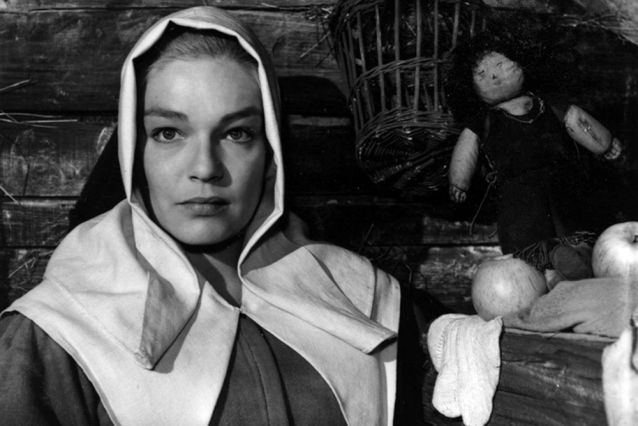Himmelfahrt einer Ikone - Deutsche Oper Berlin
Transfiguration of an icon
Ottorino Respighi’s LA FIAMMA is the tale of a witch hunt. A century later witches are seen as heroines
Nine million witches are said to have been burnt in Germany between the 15th and 18th centuries – just one of the many myths that persisted tenaciously in public perception and the media, despite having long been disproved by modern scholarship. In reality approximately 50,000 executions were carried out across Europe, a small minority of them burnings at the stake. And the paucity of public immolations was due not to a burgeoning humanism in the justice system but to the expense of it all.
Historian Wolfgang Behringer is familiar with the many persistent misconceptions, including those feeding the anti-witch mania. Trials were seldom conducted by the Church. Most were secularly brought proceedings, outbursts of local hysteria, which often snowballed into mass psychoses leading to regional mayhem and a traumatised populace. Seeing the theme of witchery as a way to make money, later generations cut corners in historical accuracy – and a long tug-of-war began over whose version of the facts could claim to be mainstream.
For LA FIAMMA, too, Ottorino Respighi and his librettist Claudio Guastalla were economical with the truth, transferring the action of a Norwegian witch trial in 1590 to 7th-century Ravenna. No matter that this predated witch trials by centuries and was alien to Byzantine Italy. By altering the era and geography of this story of love and witchcraft, they bigged up the conflict into one between Christianity and paganism, Orthodoxy and heresy. The real-life Norwegian Anne Pedersdotter becomes Silvana, the heroine, whose name is derived from the Latin for woodland and who is thus associated with a primeval wildness, a practitioner of dark arts. The title also can be variously interpreted, alluding to the flames of desire that can consume, to the protagonist’s alleged acts of sorcery, and to death at the stake.
In a society of the kind depicted in LA FIAMMA, self-confident female sexuality poses a threat to religious asceticism. With the Silvana character amplified to Phaedra dimensions (the Greek protagonist transgressed norms through her love for her stepson), she acquires a diabolical streak by knowingly bewitching her male victim. And even though the heroine falls foul of a patriarchal, Scripture-based justice system and is sentenced to death, her sexual awakening, her confession and her path to sorcery are also a story of female emancipation.
Stories, myths and oral histories are populated by witches that defy easy compartmentalisation. In the words of classical philologist Madeline Miller: »They burst descriptive boundaries and refuse to be pigeonholed. They’re constantly shifting, an ever-changing reflection of all our models of womanhood«.

Witches’ potential lies in the grey zone between reality and fiction. They are fascinating characters, narrative surfaces onto which we can project our versions of the female sorcerer - from hunchbacked crone to beautiful champion of forces for good; from feminist icon to execution victim. We can chart their constant resurgence in films and TV series, ranging from good-girl Hermine Granger in »Harry Potter« to Wednesday, the shadowy outsider in the Netflix series of the same name.
In the late 1960s the witch character was reinvented by radical feminist groups in America. In 1968 a group of feminists calling themselves W.I.T.C.H., the »Women’s International Terrorist Conspiracy from Hell«, decked itself in black cloaks and pointed hats and descended on Wall Street, laying a curse on the Stock Exchange. By their logic, if the patriarchy were to be overthrown, its very foundation - capitalism - had to be attacked. In a bizarre turn of events the Dow Jones index fell the next day. For years afterwards the group periodically made the news with performances in which they cast spells on various sectors of industry. Women in witches’ garb have since been a common sight at feminist demonstrations, including during the presidential campaign of Donald Trump.
By way of 1970s street demos modern feminism established itself at universities. The witch found its place in anthropology syllabi and gradually became an emblem for female self-determination. Mona Chollet prefaces her 2018 book »Sorcières: La puissance invaincue des femmes« (a bestseller in France) with a quotation from the W.I.T.C.H. manifesto: »You don’t have to be a WITCH supporter. If you’re a woman and you dare to peer inside yourself, you are a witch.« From the outset activists were well aware that neo-witches would have to cut the umbilical cord of religion. The witch as cultural figure was always conceived as an invitation, as an accessible model for a self-reflective femininity. Her undetermined liberty is one of the keys to her success.
Running counter to this secularity is a relatively new movement depicted by ethnologist Victoria Hegner in her 2021 work »Hexen der Großstadt«, the title referring to the city that claims to have the greatest density of witches in central Europe: Berlin. Hegner studies women who define themselves as neo-pagan witches, openly practise their new faith and are consciously reinvesting the feminist emancipatory project of witchcraft with magic, rituals and religious practices.
»For all we know, a witch could quite possibly be living right next door to you,« wrote Roald Dahl in »The Witches«. To this we might add: …or sitting right next to you in LA FIAMMA.
Tilman Mühlenberg, Samira El Ouassil





